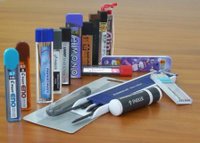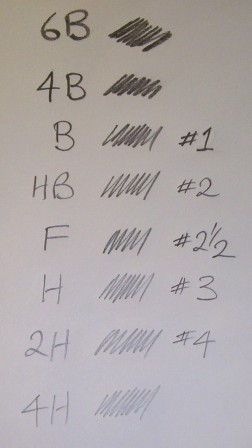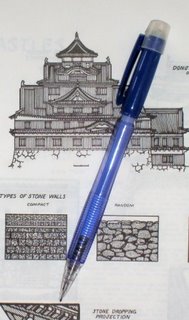 I have been prompted to publish this posting by people finding this blog with searches indicating they are looking for lists of lead diameters that are currently readily available, and some information on lead grades or hardness.
I have been prompted to publish this posting by people finding this blog with searches indicating they are looking for lists of lead diameters that are currently readily available, and some information on lead grades or hardness.Standard Mechanical Pencil Lead Sizes (diameters) (Currently In Common Use)
Lead sizes are designated by their diameter, in millimetres (mm).
0.3mm / 0.35mm (Usually the same thing, just rounded down to 0.3)
0.5mm (The common fine writing thickness)
0.7mm (Common writing thickness, stronger than 0.5)
0.9mm / 1.0mm (Usually the same)
1.18mm / 1.1mm / 1.15mm / 1.2mm (Usually the same - a whole lot of different rounding values for the same stick of lead!)
1.3mm
1.4mm
2 mm
3.15mm / 3.2mm
5.6mm
Nowadays mechanical pencil lead diameters are all measured in metric. A common writing size is 0.5mm = 0.0197 inches = about 1/50th of an inch. The lead in ordinary wood pencils is usually about 2mm = 0.0787 inches = a little under 1/12th inch.
One problem is that some sizes are frequently rounded up and/or down to another number, without any consistency, so you are sometimes unsure what diameter you really have. Many of them started out as imperial fractions of an inch so the metrication of them also produced rounding. For example 0.3mm lead is usually 0.35mm just rounded down; 1.1mm and 1.2mm are usually 1.18mm rounded down or up, but sometimes 1.1mm is really 1.1mm as distinct from 1.18mm. Sometimes 0.9mm is called 1mm. For example my Rotring Tikky 1.0 takes a 0.9mm lead. Faber-Castell lead refills are marked 1.0(0.9) and 0.35(0.3), but Pentel mark theirs the other way around, 0.3(0.35). Confusing, but in general with these “variable” leads the differences don’t seem to matter as they are all the same thickness or the pencil mechanisms involved can handle the differences.
Lead Grades / Hardness / Darkness
 There is no real standardisation of lead hardness or darkness. Leads are often called #1, #2 etc in the USA, but most of the rest of the world uses the "HB" system. H stands for Hardness and B for Black. In the middle there is also an F (for Firm). The more H's in the designation the lighter (and harder) the lead, and the more B's the softer and darker. So HB grade is Hard Black, 6B is extremely soft and dark, 4H is very hard and light. The standard writing grade is usually HB, which is about #2 in the USA. Slightly darker and softer is B, which is about #1. From the softest darkest through to the hardest lightest lead, the range is usually 6B up to B, then HB, F, and H up to 6H, but some manufactureres may go from about 9B through to 10H. As a rough guide, for the USA, #1 = B, #2 = HB, #2 ½ = F, #3 = H and #4 = 2H. But thats variable, one manufacturer marks some of their HB pencils as #2 and some as #2 ½ !?
There is no real standardisation of lead hardness or darkness. Leads are often called #1, #2 etc in the USA, but most of the rest of the world uses the "HB" system. H stands for Hardness and B for Black. In the middle there is also an F (for Firm). The more H's in the designation the lighter (and harder) the lead, and the more B's the softer and darker. So HB grade is Hard Black, 6B is extremely soft and dark, 4H is very hard and light. The standard writing grade is usually HB, which is about #2 in the USA. Slightly darker and softer is B, which is about #1. From the softest darkest through to the hardest lightest lead, the range is usually 6B up to B, then HB, F, and H up to 6H, but some manufactureres may go from about 9B through to 10H. As a rough guide, for the USA, #1 = B, #2 = HB, #2 ½ = F, #3 = H and #4 = 2H. But thats variable, one manufacturer marks some of their HB pencils as #2 and some as #2 ½ !?0.5mm and 0.7mm are unquestionably the most common lead diameters and have a wide range of hardness grades available. Other diameters have considerably less selection of brands and hardness’s. For instance in 0.5mm Pentel offer 12 grades, but only 5 grades in 0.9mm. Most manufacturers offer far fewer grades.
Another point of interest is the change from ceramic to polymer leads. Somewhere in the 1 to 2mm range they usually change. I think it’s safe to say that under 1mm they are all polymer leads, and 2mm and over are all ceramic leads. In between it’s a mixture, but mostly polymer. For instance, I believe that the standard 2mm leads sold by Staedtler and Faber-Castell are just their normal wood pencil ceramic leads (without the wood!). Leads of 2mm and over are usually for use in clutch mechanism pencils – leadholders, clutch pencils, sketch pencils or whatever you prefer to call them.













